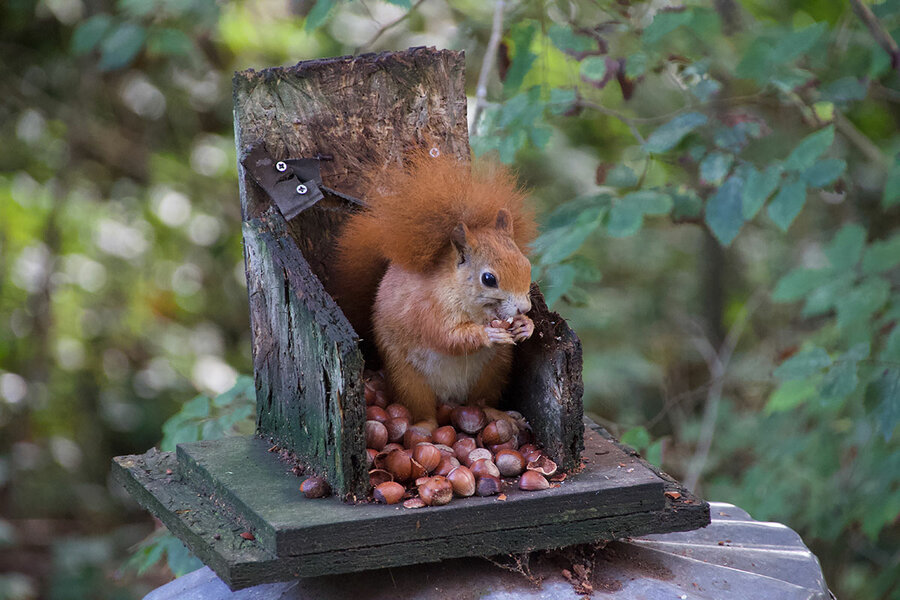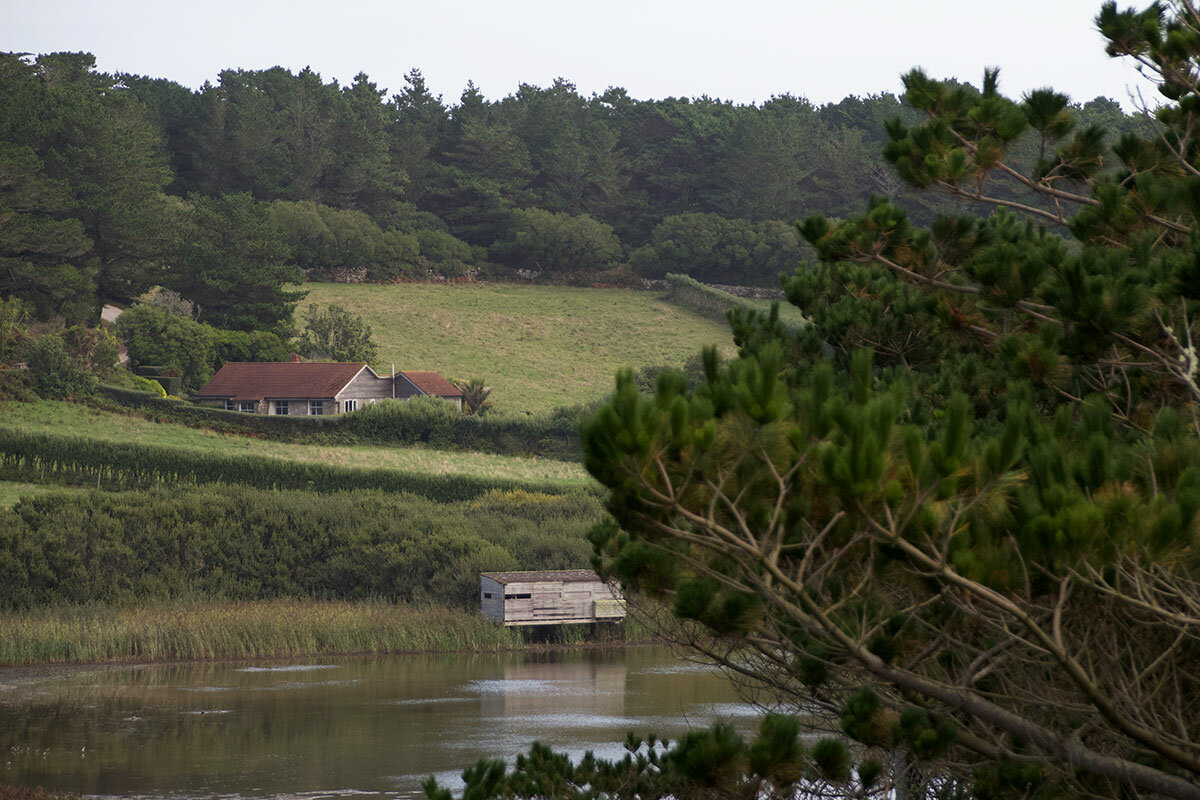Return of Nutkin: Red squirrels’ comeback in UK
Loading...
| Tresco and Hayle, England
Red squirrels were once common throughout the United Kingdom, but the invasive gray squirrel has pushed them to the brink of extinction in all but a few strongholds.
There is, however, hope of restoring them through a multipronged approach.
Why We Wrote This
A story focused onEfforts in the United Kingdom to restore the red squirrel population range from secluded sanctuaries to the reintroduction of predators.
Among the efforts is a sanctuary on Tresco – one of the Isles of Scilly off the southwest tip of England. There, red squirrels have no natural predators, and there has never been an incursion by gray squirrels.
A different approach in Anglesey, Wales, involves the reintroduction of the pine marten, a natural predator of squirrels.
“The idea is that red squirrels are very fly, and the pine marten is a natural predator of theirs, so they’re better at getting away,” says Alison Hales, director at Paradise Park, a wildlife sanctuary. “Whereas for gray squirrels, the pine marten is not a natural predator, and the grays are a bit more chunky, too, so they’re not quick enough to get away, and they’re more likely to end up as prey.”
Other approaches are also being developed that, if approved, would avoid killing grays.
As I stand on the blue bridge, gateway to a subtropical garden on this island haven near southwestern England, I look to the side and see a small creature sitting astride a mound of hazelnuts. Its fur blazes a bright russet color, its tail fanned out like a sail. I glance up, and in the neighboring pine tree I see two or three more, racing up and down the trunk, pausing every so often to steal a glance at the feast below, waiting their turn.
These are red squirrels, and to see them in the wild, let alone in such numbers, is a rare treat. The animals were once common throughout the United Kingdom, but the invasive gray squirrel has pushed them to the brink of extinction in all but a few strongholds.
There is, however, hope of a comeback. This sanctuary on Tresco – one of the Isles of Scilly lying 28 miles off the southwest tip of England – represents a part of that hope: a translocation project, where red squirrels are now thriving. And this is only one facet of a multipronged approach that seeks to reduce the exploding populations of gray squirrels and give the reds a chance of clawing back some of their native habitat.
Why We Wrote This
A story focused onEfforts in the United Kingdom to restore the red squirrel population range from secluded sanctuaries to the reintroduction of predators.
“I see it as unacceptable to do nothing,” says Sir Ferrers Vyvyan, chairman of the Cornwall Red Squirrel Project. “If we want to preserve an iconic animal of our countryside, we need to take active steps or the grays will eliminate the last few populations we have remaining.”
Red squirrels have been a part of Britain’s native fauna for thousands of years. They are emblematic of the British countryside, so much so that generations of schoolchildren have been raised on Beatrix Potter’s “tale of a tail” about a little red squirrel named Nutkin. By contrast, the first recorded introduction of North American gray squirrels into a British park occurred in the 1870s.
Through a combination of competition and the transmission of disease, the gray squirrels have all but wiped out the reds in much of the U.K. While there is debate over whether the aim should be countrywide removal of the nonnative grays, it’s clear that the two species struggle to coexist, so most experts agree that at the very least, red squirrel populations need to be defended against encroachment by their bigger cousins.
Potential on The Lizard and Land’s End
Sir Ferrers is spearheading the efforts in Cornwall to reintroduce red squirrels, but the situation is far more complex than on Tresco. There, the red squirrels have no natural predators, and there has never been an incursion by gray squirrels – not to mention the vast stretch of ocean separating Tresco from the Cornish coastline, which constitutes a formidable barrier to any grays that might have a mind to venture there.
But there are parts of Cornwall that offer potential – in particular, two peninsulas, The Lizard and Land’s End, that are surrounded on three sides by the sea. If gray squirrels could be eradicated from these areas, a buffer zone could be put in place at their necks, to keep the grays at bay.
Indeed, progress was being made on The Lizard in doing just that. But those efforts ground to a halt during the pandemic, and the gray squirrel population has rebounded.
So, the Cornish project is on pause, while its participants regroup. Sir Ferrers is determined to have the habitat ready, and a sufficient number of red squirrels lined up for reintroduction, before embarking on the final stages.
“Cornwall is a good example of very careful and guarded steps towards translocation,” says Craig Shuttleworth, honorary research fellow at Bangor University, and an adviser to the Red Squirrel Survival Trust. “The headline is that reds return to the south of England, and you can get that by being cavalier – you can grab the flag and say we’ve done it first – but you might end up on the rocks later on.”
Could predators help?
Playing a vital part in the Cornish efforts is a place called Paradise Park, a wildlife sanctuary and attraction that focuses mainly on parrots, but also hosts an abundance of other animals. Red squirrels are being bred in captivity there, and the progeny from this project have already been used to bolster a reintroduction program on the Welsh island of Anglesey.
Another success story in red squirrel conservation, Anglesey presented an entirely different challenge than on Tresco. The island off of Wales is far larger – measuring some 720 square kilometers (278 square miles) to Tresco’s 3 square kilometers (1.2 square miles) – and it was already home to a large population of gray squirrels. It is also far closer to the mainland, being separated only by a narrow body of water, with two bridges spanning the gap.
All of this meant that even though grays were successfully eradicated there in 2013, some occasionally ventured back from mainland Wales, both across the bridges and by swimming over the Menai Strait. As a result, monitoring and trapping encroaching gray squirrels had to continue.
But such a commitment of finances and personnel cannot be guaranteed indefinitely, which is why the Anglesey project is pivoting to a fresh approach based on recent research: the reintroduction of another native mammal in decline, the pine marten. Despite the pine marten being a natural predator of squirrels, the scheme is garnering increasingly broad support.
“The idea is that red squirrels are very fly, and the pine marten is a natural predator of theirs, so they’re better at getting away,” says Alison Hales, director at Paradise Park. “Whereas for gray squirrels, the pine marten is not a natural predator, and the grays are a bit more chunky, too, so they’re not quick enough to get away, and they’re more likely to end up as prey.”
Where pine martens are present, the evidence suggests that gray squirrel populations are suppressed and red squirrel numbers rebound. Projects are afoot to reintroduce pine martens in other parts of the U.K., not least in Devon, the county next to Cornwall, where the Two Moors Pine Marten Project hopes that bringing the animals back will help restore the natural balance.
But this is not the only novel approach to controlling gray squirrels – an important shift, as more traditional methods, which often include trapping and killing the animals, sometimes cause emotions to run high. The other ideas currently being developed are lacing food for gray squirrels with a contraceptive or (more controversial) using a gene drive technology that would manipulate the genetics of gray squirrels to induce infertility.
While these techniques are likely years away from widespread adoption, assuming they overcome all of the test phases and regulatory hurdles, Dr. Shuttleworth finds hope in the possibilities.
“I’m very optimistic,” says Dr. Shuttleworth, who has worked in this field for more than two decades and led the project on Anglesey. “Red squirrel conservation has a lot more local groups involved – that’s good, because if you’ve got community driving the project, it gives you sustainability.”









